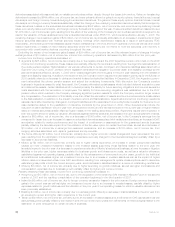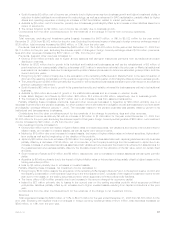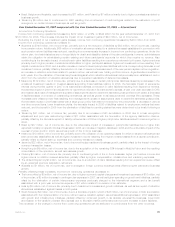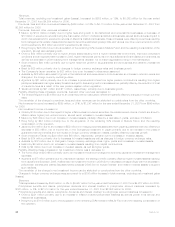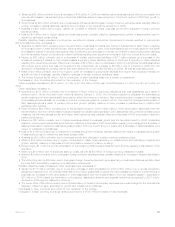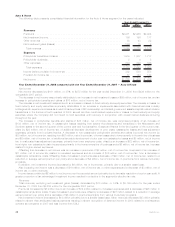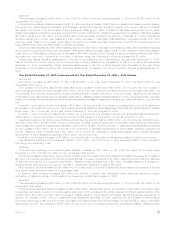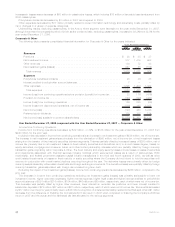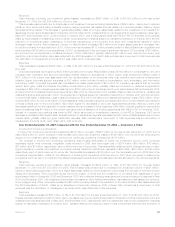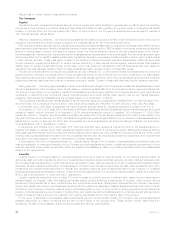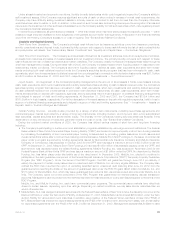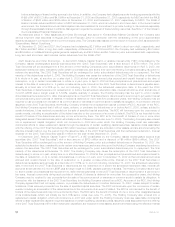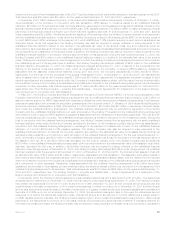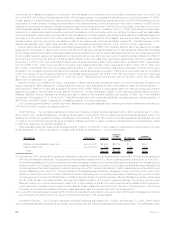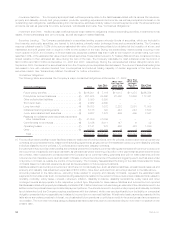MetLife 2008 Annual Report Download - page 49
Download and view the complete annual report
Please find page 49 of the 2008 MetLife annual report below. You can navigate through the pages in the report by either clicking on the pages listed below, or by using the keyword search tool below to find specific information within the annual report.commercial paper outstanding. Interest on uncertain tax positions was higher by $35 million as a result of an increase in published Internal
Revenue Service interest rates and a change in the method of estimating interest expense on tax contingencies associated with the
Company’s implementation of FIN 48. As a result of higher interest rates, interest credited on bank deposits increased by $5 million at
MetLife Bank. Corporate expenses are lower by $90 million primarily due to lower corporate support expenses of $67 million, which
included advertising, start-up costs for new products and information technology costs, and lower costs from reductions of MetLife
Foundation contributions of $23 million. Integration costs incurred in prior year were $25 million. Legal costs were lower by $11 million
primarily due to a reduction in 2007 of $35 million of legal liabilities resulting from the settlement of certain cases; lower other legal costs of
$3 million partially offset by higher amortization and valuation of an asbestos insurance recoverable of $27 million. Also included as a
component of total expenses was the elimination of intersegment amounts which were offset within total revenues.
Liquidity and Capital Resources
Extraordinary Market Conditions
Since mid-September 2008, the global financial markets have experienced unprecedented disruption, adversely affecting the business
environment in general, as well as financial services companies in particular. The U.S. Government, as well as governments in many foreign
markets in which the Company operates, have responded to address market imbalances and taken meaningful steps intended to
eventually restore market confidence. Continuing adverse financial market conditions could significantly affect the Company’s ability to
meet liquidity needs and obtain capital.
Liquidity Management. Based upon the strength of its franchise, diversification of its businesses and strong financial fundamentals,
management believes that the Company has ample liquidity and capital resources to meet business requirements under current market
conditions.
Processes for monitoring and managing liquidity risk, including liquidity stress models, have been enhanced to take into account the
extraordinary market conditions, including the impact on policyholder and counterparty behavior, the ability to sell various investment
assets and the ability to raise incremental funding from various sources. Management has taken steps to strengthen liquidity in light of its
assessment of the impact of market conditions and will continue to monitor the situation closely. Asset/Liability Management (“ALM”) needs
and opportunities are also being evaluated and managed in light of market conditions and, where appropriate, ALM strategies are adjusted
to achieve management goals and objectives. The Company’s short-term liquidity position (cash and cash equivalents and short term
investments, excluding cash collateral received under the Company’s securities lending program and in connection with derivative
instruments that has been reinvested in cash, cash equivalents, short-term investments and publicly-traded securities) was $26.7 billion
and $10.9 billion at December 31, 2008 and 2007, respectively. This higher than normal level of short-term liquidity was accumulated to
provide additional flexibility to address potential variations in cash needs while credit market conditions remained distressed. In 2009, we
anticipate short-term liquidity will be brought down in a prudent manner and invested according to the Company’s ALM discipline in
appropriate assets over time. There may be potential implications for earnings if the reinvestment process occurs over an extended period
of time due to challenging market conditions or asset availability. The asset portfolio will continue to be defensively positioned in 2009 with
an emphasis on higher credit quality, more liquid asset types. However, considering the continued, somewhat uncertain credit market
conditions, management plans to continue to maintain a slightly higher than normal level of short-term liquidity.
During this extraordinary market environment, management is continuously monitoring and adjusting its liquidity and capital plans for the
Holding Company and its subsidiaries in light of changing needs and opportunities. The dislocation in the credit markets has limited the
access of financial institutions to long-term debt and hybrid capital. While, in general, yields on benchmark U.S. Treasury securities were
historically low during 2008, related spreads on debt instruments, in general, and those of financial institutions, specifically, were as high as
they have been in MetLife’s history as a public company.
Liquidity Needs of the Insurance Business. With respect to the Company’s insurance businesses, Individual and Institutional segments
tend to behave differently under these extraordinary market conditions. In the Company’s Individual segment, which includes individual life
and annuity products, lapses and surrenders occur in the normal course of business in many product areas. These lapses and surrenders
have not deviated materially from management expectations during the financial crisis. For both fixed and variable annuities, net flows were
positive and lapse rates declined.
Within the Institutional segment, the retirement & savings business consists of general account values of $101 billion at December 31,
2008. Approximately, $97 billion of that amount is comprised of pension closeouts, other fixed annuity contracts without surrender or
withdrawal options, as well as global GICs that have stated maturities and cannot be put back to the Company prior to maturity. As a result,
the surrenders or withdrawals are fairly predictable and even during this difficult environment they have not deviated materially from
management expectations.
With regard to Institutional’s retirement & savings liabilities where customers have limited liquidity rights at December 31, 2008, there
were $3 billion of funding agreements that could be put back to the Company after a period of notice. While the notice requirements vary,
the shortest is 90 days, and that applies to only $1 billion of these liabilities. The remainder of the notice periods are between 6 and
13 months, so even on the small portion of the portfolio where there is ability to accelerate withdrawal, the exposure is relatively limited.
Withrespecttocreditratingsdowngradetriggersthatpermitearlytermination, less than $1 billion of the retirement & savings liabilities were
subject to such triggers. In addition, such early terminations payments are subject to 90 day prior notice. Management controls the liquidity
exposure that can arise from these various product features.
Securities Lending. The Company’s securities lending business has been affected by the extraordinary market environment. In this
activity, blocks of securities, which are included in fixed maturity and short-term investments, are loaned to third parties, primarily major
brokerage firms and commercial banks. The Company generally requires a minimum of 102% of the current estimated fair value of the
loaned securities to be obtained at inception of a loan, and maintained at a level greater than or equal to 100% for duration of the loan.
During the extraordinary market events occurring in the fourth quarter of 2008, the Company, in limited instances, accepted collateral less
than 102% at the inception of certain loans, but never less than 100%, of the market value of loaned such loaned securities. These loans
involved U.S. Treasury bills, which are considered to have limited variation in their market value during the term of the loan. Securities with a
46 MetLife, Inc.


